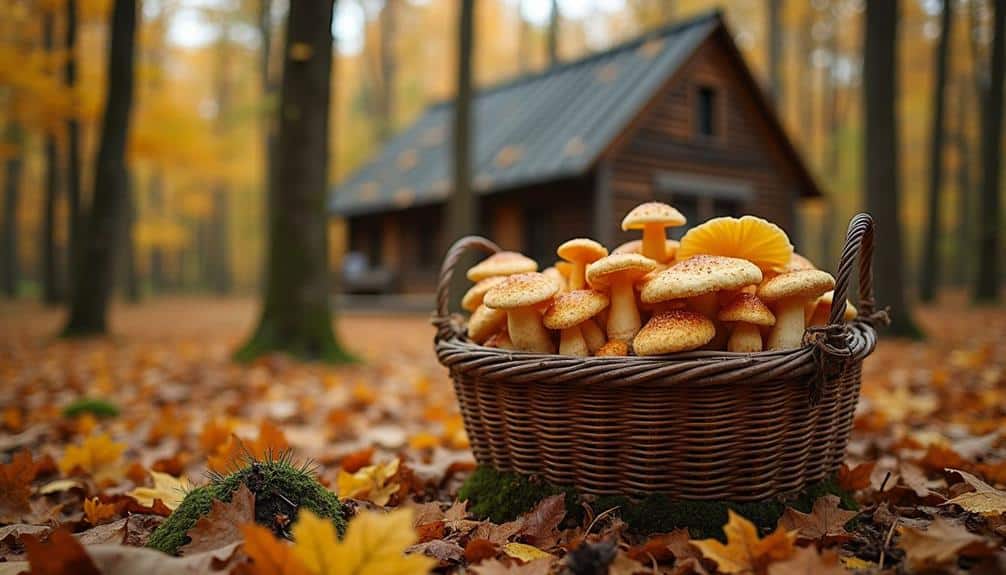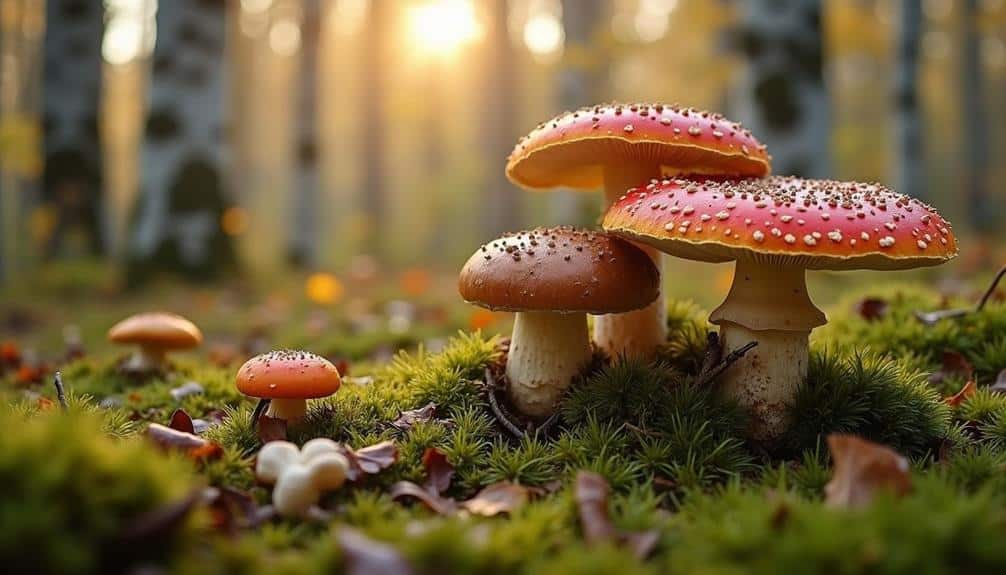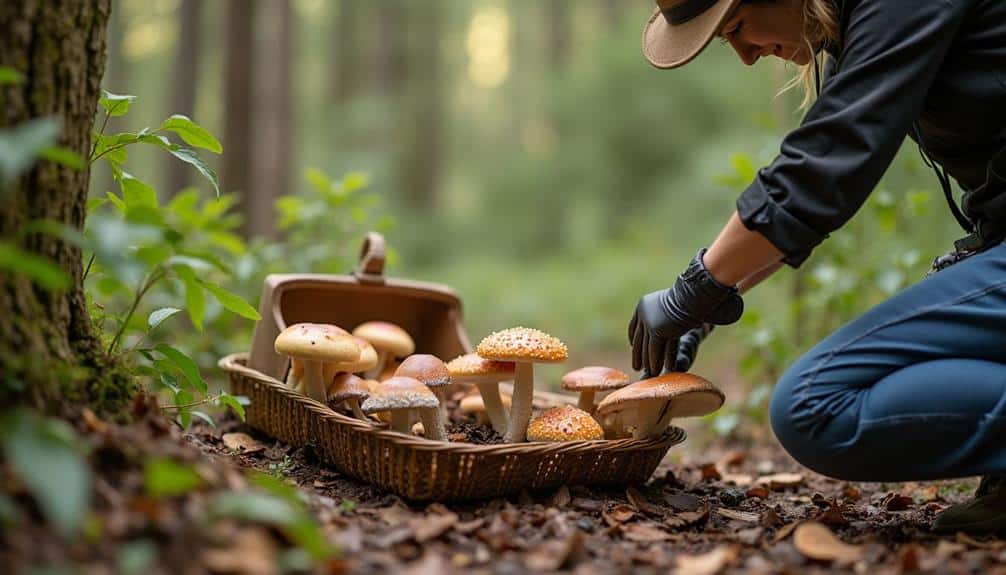The practice of mushroom hunting, known as “тихая охота” or “quiet hunting,” represents a deeply ingrained aspect of Russian heritage, intertwining historical roots with contemporary culinary arts. This tranquil pursuit not only serves as a conduit for generational knowledge transfer but also reinforces community cohesion. With the arrival of late summer, the forests teem with enthusiasts keen to gather sought-after species like Boletus edulis and chanterelles. Beyond its nostalgic charm, this tradition contributes considerably to local economies and environmental consciousness. What underpins this enduring fascination, and how does it continue to shape modern Russian society?
Historical Roots

Mushroom hunting in Russia has deep historical roots that trace back centuries, intertwining with the nation’s cultural and culinary traditions. This age-old practice is more than a mere pastime; it is a revered tradition passed down through generations.
Russian families have long undertaken expeditions into the vast forests, guided by knowledge passed orally from elders to the young, ensuring the continuity of these traditional practices.
The historical roots of mushroom hunting are deeply embedded in regional folklore, with numerous tales and legends celebrating the bounty of the forest. These stories often depict mushrooms as gifts from the forest spirits, reinforcing the profound respect and gratitude that Russian mushroom hunters hold toward nature.
This sense of reverence is palpable in the meticulous attention to detail when identifying and harvesting mushrooms, a practice that has been refined over centuries.
In various regions of Russia, specific methods and tools have been developed to enhance the efficiency and sustainability of mushroom foraging.
These regional variations highlight the adaptability and resourcefulness of Russian mushroom hunters. The enduring allure of this practice lies in its harmonious blend of tradition, folklore, and a deep-seated respect for the natural world, offering a sense of freedom and connection to the land.
Cultural Significance
The enduring tradition of mushroom hunting in Russia is not merely a reflection of its historical roots but also a demonstration of its profound cultural significance. This age-old practice transcends mere foraging to become a crucial component of Russian identity, illustrating the nation’s deep connection to nature and the land.
Mushroom hunting, or “тихая охота” (quiet hunting), embodies traditional practices that have been passed down through generations, fostering a sense of continuity and respect for the natural world.
Beyond its historical importance, mushroom hunting serves as a powerful tool for community bonding. Families and friends gather in the forests, partaking in a shared pursuit that strengthens social ties and reinforces communal values.
This collective activity allows individuals to break away from the confines of urban life, offering a liberating experience that harmonizes with the desire for freedom and personal autonomy.
Moreover, the cultural significance of mushroom hunting is celebrated in various regional festivals and culinary traditions. These events not only highlight the nutritional and gastronomic value of mushrooms but also perpetuate the communal spirit, ensuring that the practice remains an integral part of Russian cultural heritage.
Consequently, mushroom hunting in Russia is much more than a recreational activity; it is a cherished ritual that unites communities and preserves their cultural legacy.
Popular Mushroom Varieties

Among the myriad of mushrooms found in Russian forests, several varieties stand out for their popularity and culinary value. The prized Boletus edulis, known locally as “belyi grib” or “white mushroom,” is a favorite for its rich, nutty flavor and versatility in numerous dishes.
Another sought-after edible species is the Chanterelle (Cantharellus cibarius), appreciated for its vibrant yellow hue and delicate taste, often enhancing soups and sauces.
Russula, with its wide range of colors and mild flavor, also commands attention among mushroom enthusiasts. These mushrooms are particularly valued for their ease of identification, making them a frequent choice for novice foragers.
Meanwhile, the Lactarius deliciosus, or “saffron milk cap,” is renowned for its unique orange color and slightly spicy taste.
Mastering foraging techniques is vital to guarantee the successful and safe collection of these fungi. Seasoned foragers advise paying close attention to the forest floor’s microhabitats, as many edible species have specific growth preferences.
Knowledge of distinguishing features, such as cap shape, gill structure, and spore color, is essential in avoiding toxic look-alikes. Consequently, the allure of mushroom hunting lies not only in the culinary rewards but also in the thrill of the chase.
Seasonal Timing
Timing your foraging expeditions to align with peak mushroom seasons is essential for a successful and bountiful harvest in Russia’s diverse forests. Understanding the intricate relationship between mushroom growth and weather patterns is vital for seasoned and amateur foragers alike.
In Russia, the primary mushroom hunting season runs from late summer to early autumn, typically from August to October, when the weather conditions favor the proliferation of various fungi species.
The ideal conditions for mushroom growth are largely influenced by a combination of moisture and temperature. Following a period of rainfall, coupled with mild temperatures, the forest floor becomes a fertile ground for mushrooms to flourish.
The late summer rains and the subsequent humid weather create a perfect environment for species like chanterelles, boletes, and russulas to emerge in abundance.
Monitoring weather patterns is a key strategy for maximizing your foraging success. Experienced hunters often keep a close eye on local weather forecasts, planning their trips shortly after rain showers to capitalize on the new growth.
Safety and Best Practices

When commencing a mushroom hunting expedition in Russia, prioritizing safety and adhering to best practices is essential for a rewarding and secure experience. Understanding mushroom identification is vital, as the Russian forests are home to both delectable and deadly species. Investing in a high-quality field guide and familiarizing oneself with common edible and toxic varieties can mitigate risks.
Additionally, joining local foraging groups or employing a knowledgeable guide can enhance one’s identification skills and confidence. Foraging guidelines suggest that hunters should avoid picking mushrooms they cannot definitively identify.
It is also advisable to gather mushrooms in a basket rather than plastic bags to prevent spoilage and promote spore dispersal, which supports forest ecosystems. Wearing appropriate attire, including long sleeves and sturdy boots, protects against ticks and rough terrain, further ensuring a safe venture.
Moreover, it is important to forage sustainably. Harvest mushrooms by cutting them at the base rather than uprooting them, preserving the underlying mycelium for future growth. Respecting nature and local regulations not only protects the environment but also sustains the tradition of mushroom hunting for future generations.
Culinary Delights
While safety and best practices form the backbone of a successful mushroom hunting expedition, the true reward often lies in the culinary treasures these forest finds can offer. Russia’s rich foraging tradition intertwines with its culinary heritage, creating a tapestry of flavors that can only be experienced through the freshest wild mushrooms.
With expert foraging techniques, enthusiasts can identify and gather a variety of prized species, including chanterelles, boletes, and morels, each bringing its unique taste and texture to the table.
The artistry of mushroom recipes in Russia is a reflection of the nation’s deep-rooted connection with nature. Simple preparations allow the inherent flavors to shine, with classics such as creamy mushroom stroganoff and hearty mushroom soup.
More adventurous dishes, like marinated mushrooms or mushroom-filled pelmeni, invite cooks to explore the full potential of their foraged bounty. These recipes not only satisfy the palate but also evoke a sense of freedom, as each bite connects the eater to the wild origins of the ingredients.
Through foraging techniques and time-honored mushroom recipes, the culinary delights of mushroom hunting in Russia offer an unparalleled gastronomic journey, celebrating both nature’s bounty and human ingenuity.




